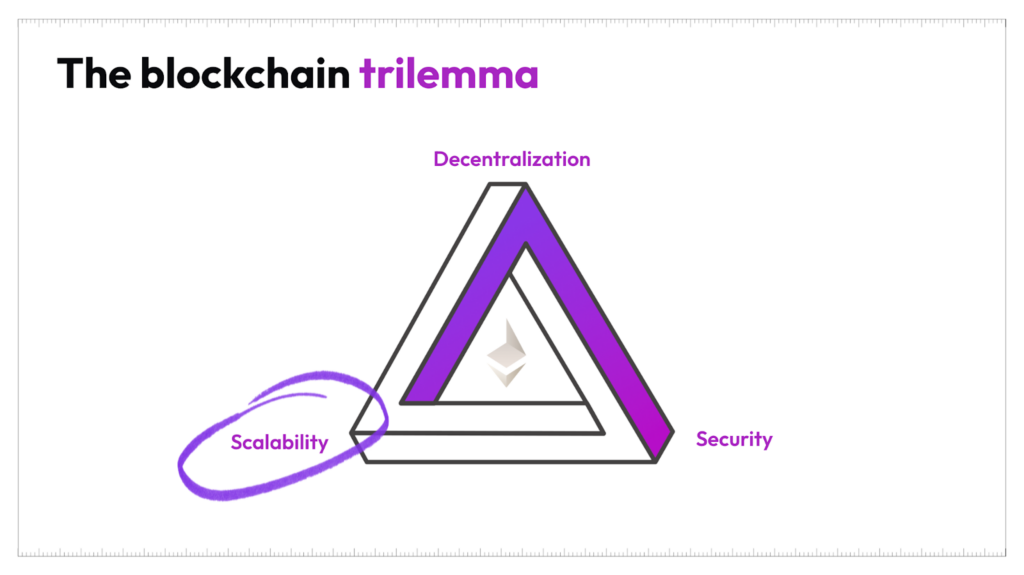Polygon vs. Ethereum: Why Choose Polygon for Scalable, Low-Cost DApps

Ethereum has been a widely used blockchain platform for years due to its secure network. However, it still needs to address the issue of scalability. What do we mean by scalability?
As said by the polygon itself:
“While it’s not incorrect to say that Ethereum moves slowly, it’s more accurate to say that Ethereum moves securely. Slowness is a byproduct.”
It is important to note that the meticulous process of ensuring the security of the network is equally necessary as it is a drawback. However, it also creates a bottleneck, especially during peak usage times, leading to delays and frustration for users.
As more users attempt to enter simultaneously, congestion builds up, which results in higher “gas fees” paid to miners to process transactions. These fees can become prohibitively expensive, creating a barrier for everyday users and hindering the mainstream adoption of dApps built on Ethereum.
In response to Ethereum’s scalability issues, Polygon was born in India in 2017 as an L2 solution that enables developers to build dApps on Ethereum without inheriting its limitations.
This post explores how Polygon overcomes Ethereum’s limitations while maintaining network security. Polygon is an ideal blockchain platform for building DApps. By understanding how it works, you can confidently leverage its capabilities for your next project.
Polygon: Scaling Ethereum Without Compromise
Polygon is a layer 2 solution designed to enable developers to build on Ethereum without encountering its limitations. Layer 2 chains are connected to an independent chain such as Ethereum. While Ethereum operates on its own, Layer 2 depends on it for security and finality. Layer solutions expand the functionality of the parent chain, but they do not replace it.

SOURCE: Polygon
The problems that Polygon solves include:
- Network Congestion: Imagine a crowded highway – slow and frustrating. Ethereum’s limited capacity created similar problems.
- High Network Fees: Like expensive tolls, high fees hindered Ethereum’s accessibility.
- Lower Transaction Throughput: Think of slow-moving cars – few transactions could be processed per second on Ethereum.
How Does Polygon Scale Ethereum? A Toolbox of Techniques
Polygon, as a blockchain network, aims to solve one of the biggest challenges of blockchain technology, i.e., scalability. It achieves this goal by utilizing a range of scaling techniques that are tailored to address specific scalability issues.
State Channels
State channels represent a scaling technique that enables off-chain transactions with on-chain settlements. In this model, participants engage in direct interactions off the main blockchain, conducting transactions privately and swiftly.
The key feature of state channels lies in their ability to reduce the burden on the main blockchain by handling multiple transactions off-chain. Once the transactions are completed, a final state is settled on the main chain, ensuring security and transparency.
State channels offer significant benefits in terms of scalability and cost-effectiveness, making them a popular choice for applications requiring frequent interactions and microtransactions.
Plasma Chains
Plasma chains operate as another layer of scalability, providing a framework for creating hierarchical blockchains that periodically submit transaction summaries to Ethereum’s main chain. These chains enable users to conduct transactions within a more contained environment while still benefiting from the security and consensus mechanisms of the main Ethereum network.
Plasma chains are particularly useful for applications requiring high throughput and rapid transaction processing. By segregating transactions into separate chains and periodically anchoring them to the main Ethereum blockchain, plasma chains mitigate congestion and improve overall scalability.
ZK-Rollups
Zero-knowledge rollups, or ZK-Rollups, represent a cutting-edge scaling solution that leverages zero-knowledge proofs to validate transactions without revealing sensitive information. In ZK-Rollups, transactions are aggregated off-chain and bundled into a single cryptographic proof, which is then submitted to the main Ethereum blockchain.
Unlike traditional transactions, where each step is publicly visible, ZK-Rollups offer a high degree of privacy and confidentiality, making them ideal for applications requiring data protection and anonymity. By combining efficiency with trustlessness, ZK-Rollups enhances Ethereum’s scalability while upholding its core principles of security and decentralization.
Optimistic Rollups
Optimistic Rollups operate on a similar principle to ZK-Rollups but with a focus on efficiency and simplicity. In Optimistic Rollups, transactions are grouped into batches and processed off-chain, with only the transaction summaries submitted to the main Ethereum blockchain. The key distinction lies in the validation process, where transactions are initially assumed to be valid unless proven otherwise.
This optimistic approach reduces computational overhead and accelerates transaction processing, making Optimistic Rollups an attractive scaling solution for applications requiring real-time responsiveness and low latency. While offering less privacy compared to ZK-Rollups, Optimistic Rollups excel in terms of simplicity and ease of implementation.
Polygon 2.0: The Future of Scalable dApps
Polygon 2.0 is an ambitious vision that caters to diverse dApp needs. It envisions a network of interoperable chains, each optimized for specific use cases. This means, for example, a gaming dApp can leverage a high-throughput chain, while a DeFi platform can prioritize security over transaction costs.
Looking ahead, Polygon 2.0 represents a visionary approach to scalable dApp development, offering interoperable chains optimized for diverse use cases. With protocols like Polygon PoS, zkEVM, and CDK already in operation, Polygon aims to facilitate near-instant cross-chain transactions while maintaining compatibility with Ethereum’s ecosystem. This interoperability not only enhances scalability but also fosters innovation and collaboration across decentralized networks.
The Verdict: Polygon – A Scalable and Cost-Effective Choice
If you’re looking to build a dApp on Ethereum, Polygon offers a compelling solution. It combines the security and decentralization of Ethereum with the scalability and affordability needed for real-world adoption. Remember, there’s no one-size-fits-all answer, but with its diverse toolbox and future-oriented vision, Polygon is definitely worth considering for your next dApp project.
Interested in delving into the technology for your next dApp project? Connect with HCode’s team of blockchain experts.
